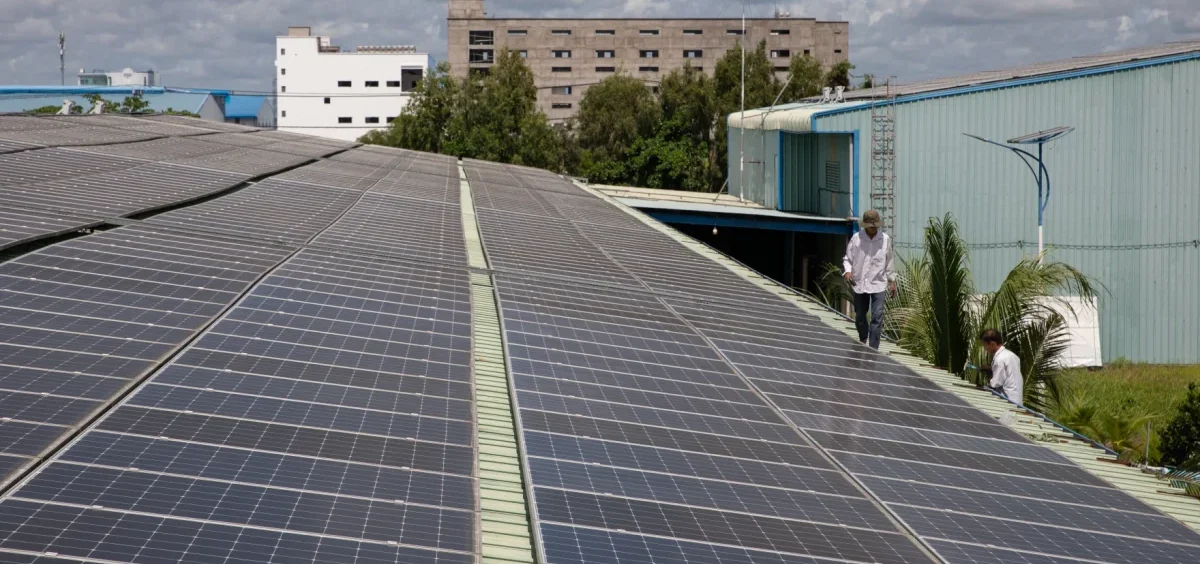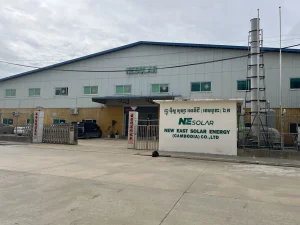News

What Trump’s win could mean for solar manufacturing in Ohio
By: Leila Goldstein | The Ohio Newsroom
Posted on:
PHNOM PENH, Cambodia (The Ohio Newsroom) — Pulling up to the entrance of a solar panel factory outside Cambodia’s capital, a poster greets visitors with New East Solar Energy’s vision: Three manufacturing bases for the American market. Below are pictures of the company’s Cambodia plant and planned factories in Batam Island, Indonesia as well as Phoenix.
Over the last 15 years, Chinese solar manufacturers have moved production from China to Taiwan to Southeast Asia in order to avoid taxes on imports to the U.S. Now, with higher tariffs being imposed on imports from four Southeast Asian countries, some foreign companies like New East – which announced plans to open an Arizona factory in September of last year – are looking to build factories on American soil and take advantage of government incentives. But that could prove risky for China-linked companies under the new Trump administration.
An Ohio factory
A new factory in Pataskala in Central Ohio started pumping out solar panels in February. The opening of the Illuminate USA facility, a joint venture between a Chicago-based developer and a Chinese solar giant, was not without controversy.
At a city council meeting in January, residents attended wearing t-shirts with the words “not in Pataskala” along with a black X crossing out the communist hammer and sickle symbol.
“I’m absolutely dumbfounded that there was not more discernment in locating a more viable American business in our community that did not have ties to our mortal enemies,” said Pataskala resident Jerry Forns at the meeting.
Local residents are not the only ones who have taken issue with China-backed factories being built in the U.S. In July a group of bipartisan senators, including Senator Sherrod Brown, proposed legislation that would specifically block Chinese companies from benefiting from the Inflation Reduction Act tax incentives.
President-elect Donald Trump has promised an aggressive approach to China that may dissuade even major manufacturers from coming to the U.S. One of China’s largest solar producers, Trina Solar, sold off its brand new Texas factory just a day after Trump was elected.

“Most of the general public does not understand that most of the supply chain is going to come from China, whether they like it or not. And if it’s not the supply chain, it’s going to be the equipment,” he said. “The made in the USA label is very, very misleading.”
Lezcano says the U.S. has had little expansion upstream in the solar supply chain, like the production of the raw materials or solar cells used when assembling solar panels.
China produces around 90% of the world’s polysilicon, a key raw material used in most solar panels. In 2022, around one-third of the global solar-grade polysilicon was produced the Xinjiang region, according to the industry specialist Bernreuter Research. The U.S. has accused the Chinese government of committing human rights violations in the region, largely against Uyghurs, the Muslim ethnic minority in the country.
The U.S. bans imports of products with links to Xinjiang through the Uyghur Forced Labor Prevention Act. But a 2023 report from the UK’s Sheffield Hallam University found that the vast majority of modules produced globally continue to have exposure to the region.
With the exception of solar manufacturer Qcells’ investments in a Georgia facility, which plans to turn raw polysilicon produced in America into solar cells, Lezcano says most of the solar factories coming online in the U.S. are assembly factories, where workers put together solar cells shipped from abroad and turn them into solar panels.
“The reliance on China for solar manufacturing is not going to change no matter what the U.S. tries to do, because the U.S. will never be able to reach the scale and magnitude that the Chinese manufacturers in the Chinese market have been able to create,” he said.
An uncertain future
While the new Trump administration is likely to be more hawkish on China, it is unclear how American solar producers, like Ohio-founded First Solar, will fare under his presidency.
First Solar originally agreed to be interviewed for this story but later declined following November’s election.
“There is a lot the company is trying to sift through right now coming out of the elections, so we are proceeding cautiously with our public and media engagement until we have a clearer sense of the landscape going forward,” said John Kyte of Kyte Consulting, a communications firm whose client is First Solar, in an email to The Ohio Newsroom.
Quill Robinson, assistant director and associate fellow with the Energy Security and Climate Change Program at the Center for Strategic and International Studies, says the future of solar under the new administration is uncertain.
“We have an incoming administration that, while far more critical of a technology like wind than solar, they are not as convinced about the benefits of clean energy technologies relative to fossil fuels,” he said.
While the Greenhouse Gas Reduction Fund and EV tax credits have been criticized by Republicans generally and Trump’s team specifically, Robinson says manufacturing tax credits may be less likely targets.
But domestic solar manufacturers are reliant on government incentives to stay competitive with the solar prices of foreign producers, which continue to drop, Robinson says, making the new administration’s policy decisions even more important to the American industry.
For its part, First Solar seems excited about Trump’s presidency. The solar manufacturer with three plants in Wood County and 2,400 employees in Ohio congratulated the president-elect in a press release, adding that the company shared the new administration’s agenda to “win the energy technology race against China.”
This is the final story in a three-part series about the impact of solar tariffs on manufacturing overseas and in Ohio. The series was supported by the Pulitzer Center.

